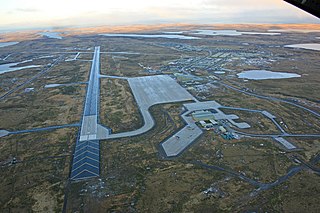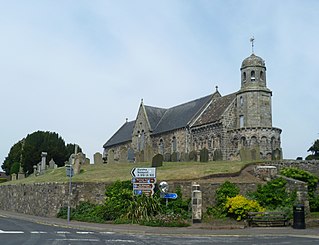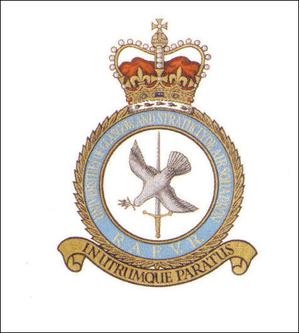
The Royal Air Force (RAF) is the United Kingdom's air and space force. It was formed towards the end of the First World War on 1 April 1918, becoming the first independent air force in the world, by merging the Royal Flying Corps (RFC) and the Royal Naval Air Service (RNAS). Following the Allied victory over the Central Powers in 1918, the RAF emerged as the largest air force in the world at the time. Since its formation, the RAF has played a significant role in British military history. In particular, during the Second World War, the RAF established air superiority over Hermann Göring's Luftwaffe during the Battle of Britain, and led the allied strategic bombing effort.

RAF Mount Pleasant is a Royal Air Force station in the British Overseas Territory of the Falkland Islands. The airfield goes by the motto of "Defend the right" and is part of the British Forces South Atlantic Islands (BFSAI). Home to between 1,000 and 2,000 British military personnel, it is about 33 miles (53 km) southwest of Stanley, the capital of the Falklands—on the island of East Falkland. The world's longest corridor, 2,600 feet (800 m) long, links the barracks, messes, and recreational and welfare areas of the station, and was nicknamed the "Death Star Corridor" by personnel.

Royal Air Force Lossiemouth or more commonly RAF Lossiemouth is a military airfield located on the western edge of the town of Lossiemouth in Moray, north-east Scotland.

Royal Air Force Coltishall, more commonly known as RAF Coltishall, is a former Royal Air Force station located 10 miles north-north-east of Norwich, in the English county of Norfolk, East Anglia, which operated from 1939 to 2006.

Royal Air Force Kinloss, or more simply RAF Kinloss, is a former Royal Air Force station located near the village of Kinloss, on the Moray Firth in the north east of Scotland, UK.

Royal Air Force Coningsby or RAF Coningsby, is a Royal Air Force (RAF) station located 13.7 kilometres (8.5 mi) south-west of Horncastle, and 15.8 kilometres (9.8 mi) north-west of Boston, in the East Lindsey district of Lincolnshire, England. It is a Main Operating Base of the RAF and home to three front-line Eurofighter Typhoon FGR4 units, No. 3 Squadron, No. 11 Squadron and No. 12 Squadron. In support of front-line units, No. 29 Squadron is the Typhoon Operational Conversion Unit and No. 41 Squadron is the Typhoon Test and Evaluation Squadron. Coningsby is also the home of the Battle of Britain Memorial Flight (BBMF) which operates a variety of historic RAF aircraft.

Number 6 Squadron of the Royal Air Force operates the Eurofighter Typhoon FGR.4 at RAF Lossiemouth. It was previously equipped with the SEPECAT Jaguar GR.3 in the close air support and tactical reconnaissance roles, and was posted to RAF Coltishall, Norfolk until April 2006, moving to RAF Coningsby until disbanding for the first time in its history on 31 May 2007. The squadron officially reformed as a Typhoon squadron on 6 September 2010. No. 6 Squadron is unique in having two Royal standards, having been awarded its second one by King Abdullah I of Jordan in October 1950 due to its long period of service in the Middle East.

The Royal Air Force Regiment is part of the Royal Air Force and functions as a specialist corps. Founded by Royal Warrant in 1942, the Corps carries out soldiering tasks relating to the delivery of air power. Examples of such tasks are non-combatant evacuation operation (NEO), recovery of downed aircrew, and in-depth defence of airfields by way of aggressively patrolling and actively seeking out infiltrators in a large area surrounding airfields. In addition the RAF Regiment provides Joint Terminal Attack Controllers (JTACs) to the British Army in the Tactical Air Control Party (TACP) role, and provides flight size commitment to the Special Forces Support Group.
Options for Change was a restructuring of the British Armed Forces in summer 1990 after the end of the Cold War.

Leuchars is a small town and parish near the north-east coast of Fife in Scotland.

Redford Cavalry and Infantry Barracks is a military installation located on Colinton Road, near the Edinburgh City Bypass, east of the suburb of Colinton in Edinburgh, Scotland. The barracks are set to close in 2029.
On 1 April 2006 Expeditionary Air Wings (EAWs) were formed at nine of the RAF's Main Operating Bases. Each EAW has its own identity and is led by the Station Commander, supported by their Station management team. The deployable elements of the station structures form the core of each EAW, reinforced by elements of the Air Combat Service Support Units (ACSSUs). Flying and Force Protection force elements are attached to meet the requirements of each operation. EAWs enable the RAF to train as cohesive air power units which are prepared and capable of transitioning quickly from peacetime structures and deploying swiftly on operations in tailored packages.

A Royal Air Force University Air Squadron recruiting within Scotland, Universities of Glasgow and Strathclyde Air Squadron draws its members from six higher education establishments within Glasgow and its surrounding areas.

Kinloss Barracks is a military installation located near the village of Kinloss, on the Moray Firth in the north of Scotland. Until 2012 it was a Royal Air Force (RAF) station, RAF Kinloss.

The Scottish and North Irish Yeomanry (SNIY) is a reserve Light Cavalry Regiment, formed in 2014, created out of the restructuring of the British Army's Army Reserve. It is operationally paired with The Royal Scots Dragoon Guards, based at Leuchars Station in Fife. The Regiment has numerous squadrons across Scotland and Northern Ireland.

Royal Air Force Leuchars or more simply RAF Leuchars is a former Royal Air Force station located in Leuchars, Fife, on the east coast of Scotland. Throughout the Cold War and beyond, the station was home to fighter aircraft which policed northern UK airspace. The station ceased to be an RAF station at 12:00 hrs on 31 March 2015 when it became Leuchars Station and control of the site was transferred to the British Army. The RAF temporarily returned to Leuchars between August and October 2020 to carry out QRA (I) responsibilities while runway works were being carried out at RAF Lossiemouth.

The page contains the current structure of the British Army. The British Army is currently being reorganised to the Future Soldier structure.
This is the structure of the Royal Air Force, as of October 2020.

This is a list of active military units, bases and barracks in Scotland. The armed forces in Scotland include the military bases and organisation in Scotland or associated with Scotland. This includes servicemen and women from Scotland and Scottish regiments and brigades of the British Armed Forces. The Military in Scotland includes the three services. The Army which has bases across Scotland, the RAF and the Navy.



















